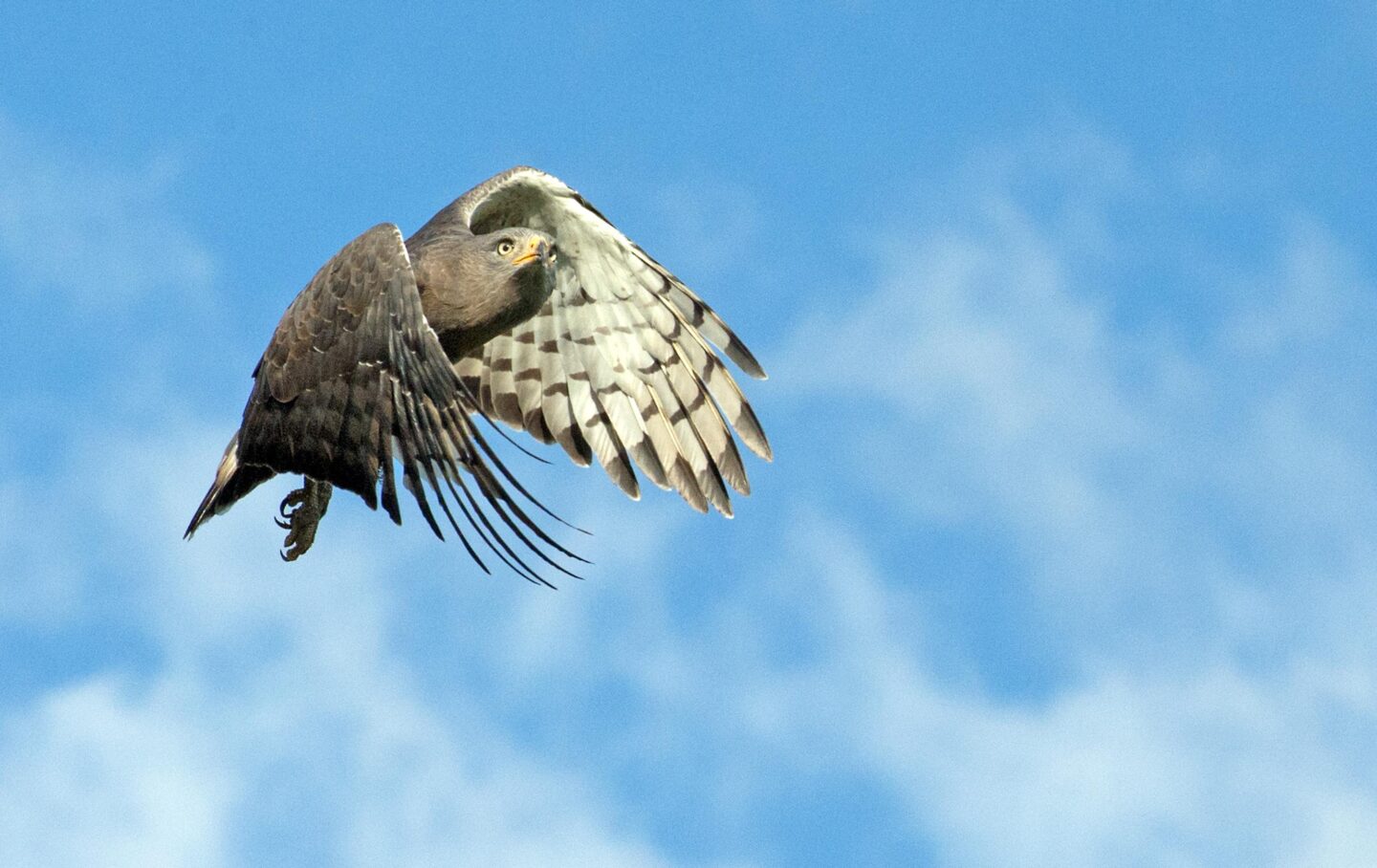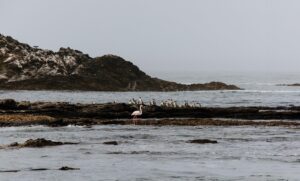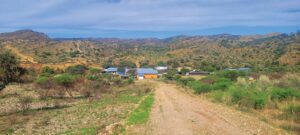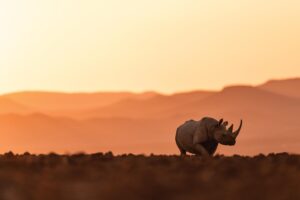

Birding with Pompie
Slowness
“Why has the pleasure of slowness disappeared?
Ah, where have they gone, the amblers of yesteryear?”
– Milan Kundera
Text Pompie Burger | Photographs Pompie Burger
From the Spring 2021 issue
Namibia is a large country, size does indeed matter, so driving and being on the road will be part and parcel of travelling (and bird watching) in this vast and beautiful country. To get to the different hotspots for birding you need to do the travel thing (remember slowness), be it by car, boat or on foot, although I must confess Namibians are not known for the foot thing.
If you drive at a speed of 200 km an hour the only bird you will see is maybe an Ostrich, so if this is the only bird you want to see you might be lucky, but I am afraid there are a lot of other birds which are much more impressive and satisfying to look out for than the world’s largest and fastest (size and speed) bird on foot. Roadside bird watching is unfortunately mostly about raptors, of which Namibia has more than 52 different kinds, so if you are a raptophile you will seldom be disappointed when driving slowly. As most birders will know, novice or professionals, the immature raptor factor comes into play and if you find more than the allocated 52 raptors you might have misinterpreted some of them as new birds.
To speculate on the hotspots of birding in Namibia is a bit of a bummer, maybe deciding beforehand on what your needs are will help. For the professional birder, the Western Bypass / Fairy Circle is the way to go. Along the western part of Namibia in the pro-Namib region you can start at Sossusvlei driving north up to the Kunene River and will most probably end up seeing all 13 of Namibia’s endemic species. The only true endemic, the Dune Lark, is obviously in the dunes, with the area around Sossusvlei your most likely hotspot, (between the Fairy Circles). If you start at the bottom (further south), Barlow’s Lark is found east and southeast of Lüderitz, while Gray’s Lark occurs all the way from the Orange River up to the Kunene River. The Damara Tern is common all along the coast.
Moving more inland from the coast, Rüppel’s Korhaan is quite common and not that difficult to spot, because of its size and its semi-desert habitat. The central highlands host the most diverse group of endemics like Rüppel’s Parrot, Carp’s Tit, Violet Wood-Hoopoe, Monteiro’s and Damara Hornbills. The White-tailed Shrike is the icon of the endemics while the Bare-cheeked Babbler is the most vocal, moving around on the ground disturbing the leaves, insects and humans along the way. The Rockrunner and Hartlaub’s Spurfowl prefer rocky mountainous areas. Luckily they are very vocal and musical, so finding them is usually much easier by listening/calling.
If you happen to go as far as the Kunene River, the Red-necked Spurfowl, Rufous-tailed Palm-Thrush and Grey Kestrel must be on every birder’s menu. The Cinderella Waxbill apparently is present in large numbers during the winter months (I still have to see one myself), while the Angolan Cave Chat, if you like caves, is somewhere in the vicinity of the Zebra Mountains (professional guide advisable). The western counterpart of the Southern Carmine Bee-eater is the Madagascar Bee-eater, a breeding migrant to this area, occurring as far south as Khorixas.
Probably the hotspots as far as numbers (for common people like me) are concerned, are Etosha National Park and the whole of north-eastern Namibia, i.e. the Kavango and Zambezi regions. Visiting Namibia without going to Etosha is like visiting RSA without looking for fraud or looting of a mall. Apart from the endemics occurring in the western part of Etosha (Okaukuejo), raptors are abundant in numbers and variety throughout the park. Look out for the Martial Eagle, Pale Chanting Goshawk (the Dark one is in the Zambezi Region), Tawny Eagle, Gabar Goshawk, Pygmy Falcon (along with their nesting hosts, the Sociable Weavers), African Harrier Hawk and Black-chested Snake-Eagle. I can go on and name all 42 raptors occurring here, but this might get boring, except if you see them. Vultures are obviously common, because lions are common. White-backed and Lappet-faced are the dominant species.
The Zambezi Region is well known for its variety, be it waterbirds, raptors or forest birds. The main reason for the abundance and variety of birds is the vast number of different habitats. Water birds are common because water is common! Do yourself a favour and look for the Pygmy Goose, the smallest goose in the world. Apparently, the Slaty Egret and Rufous-bellied Heron are rather special for foreigners but for us Namibians they are common. Raptors to look for are the Western Banded Snake Eagle, Lizard Buzzard, Dickenson’s Kestrel, Bat Hawk and Ayres’s Hawk-Eagle. The one bird which is a must to find is Pell’s Fishing Owl, but again I suggest some professional guidance.
Last but not least, my personal favourite bird/spot is the Southern Carmine Bee-eater in the Zambezi Region. The breeding colony (the largest in the world) along the Zambezi River at Mubala is a must on your list. Seeing thousands of these beautiful birds congregating at the end of August to breed is a sight never to forget. In the process their natural enemies are also rather exciting (though not for them), like the African Marsh Harrier, Yellow-billed Kite, Black Mamba etc. While you are in the area, look for the White-backed Duck, White-crowned Lapwing and the Black Coucal (a summer visitor). A trip on the Zambezi River will, apart from all the water birds, take you to another fascinating sighting, the breeding ground/beaches of the African Skimmer. Just ignore the fishermen on the river, they will settle down at sunset with their B&C around a campfire.
I will skip the migrants because they might be from your region and thus I would be duplicating unnecessarily. To name all the wonderful birding spots and all the wonderful birds in less than a thousand words is impossible, so forgive me (birds) for not mentioning all of you. The lodge owners can contact me directly for an invitation to their lodge, B&C on the house please. As far as sea birds are concerned, rather ask somebody else who knows better than me.
Slowness, patience and size are still the mainstay of our country. Slowness at the border post, patience at the Ministry of Home Affairs and the size of your excitement to meet all the wonderful birds of Namibia. TNN






